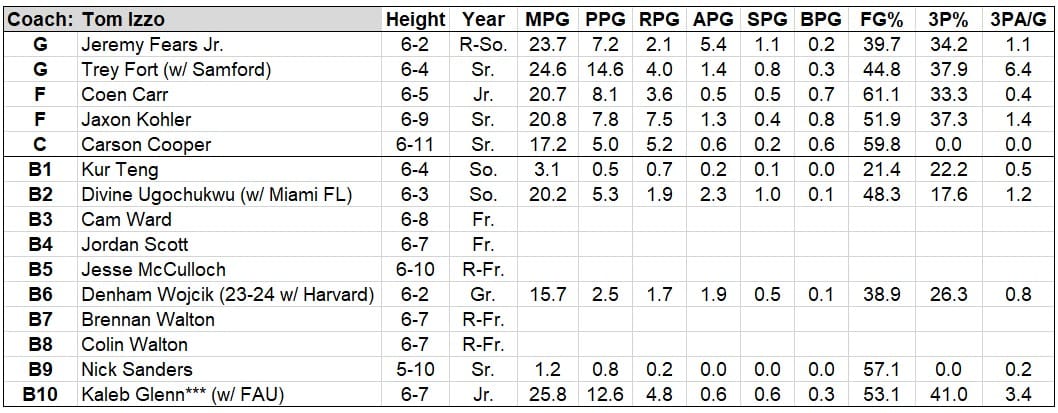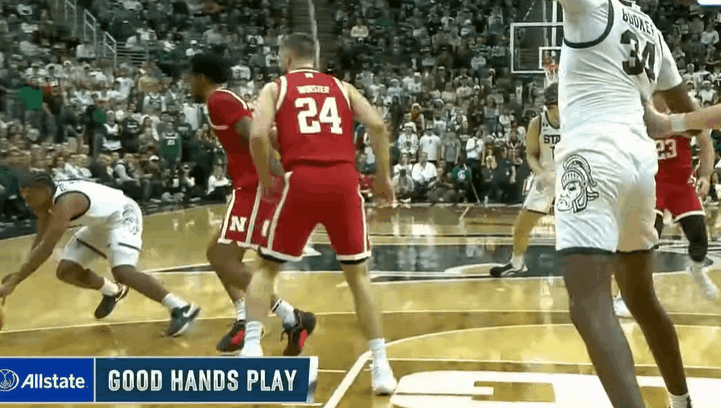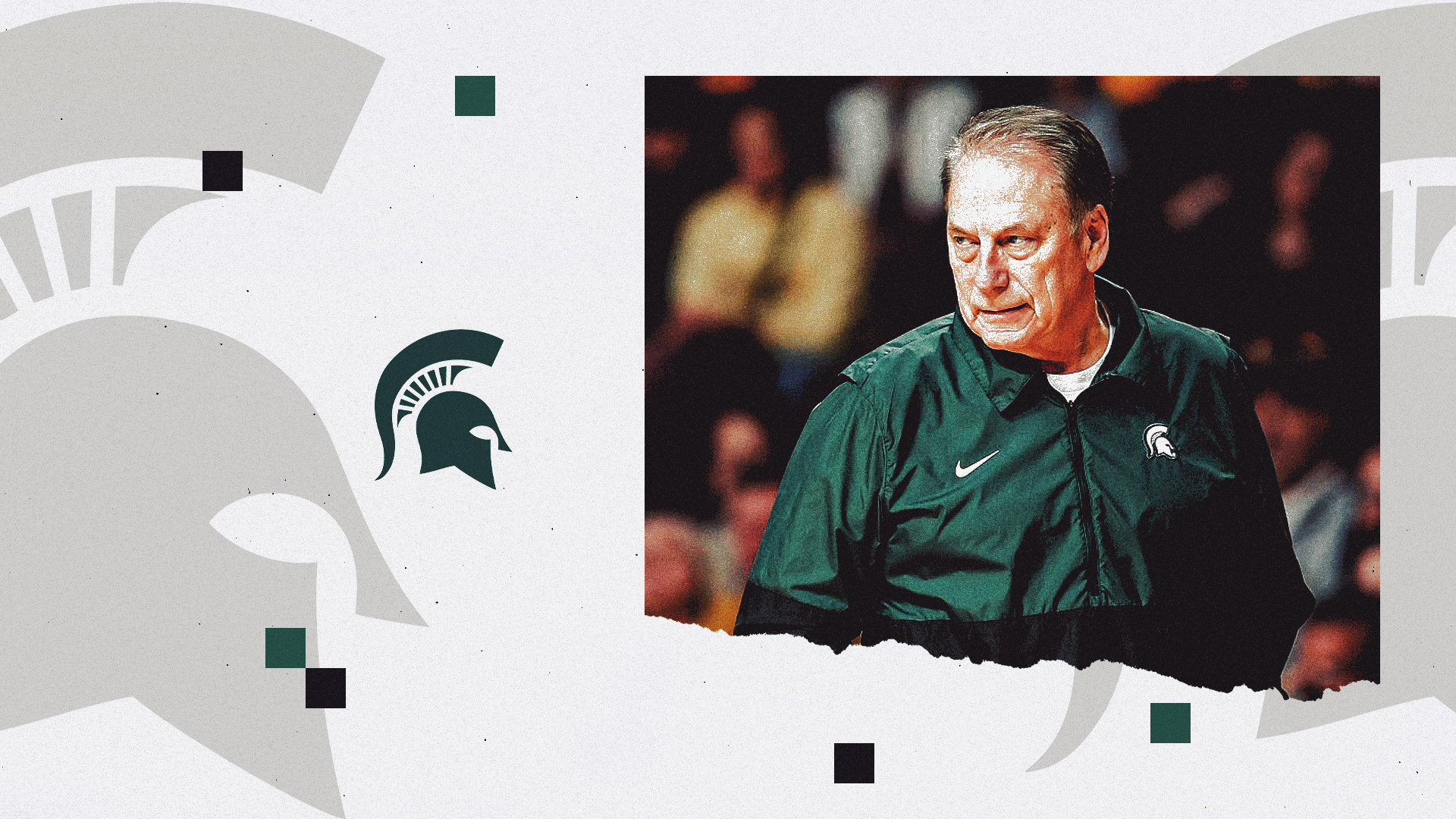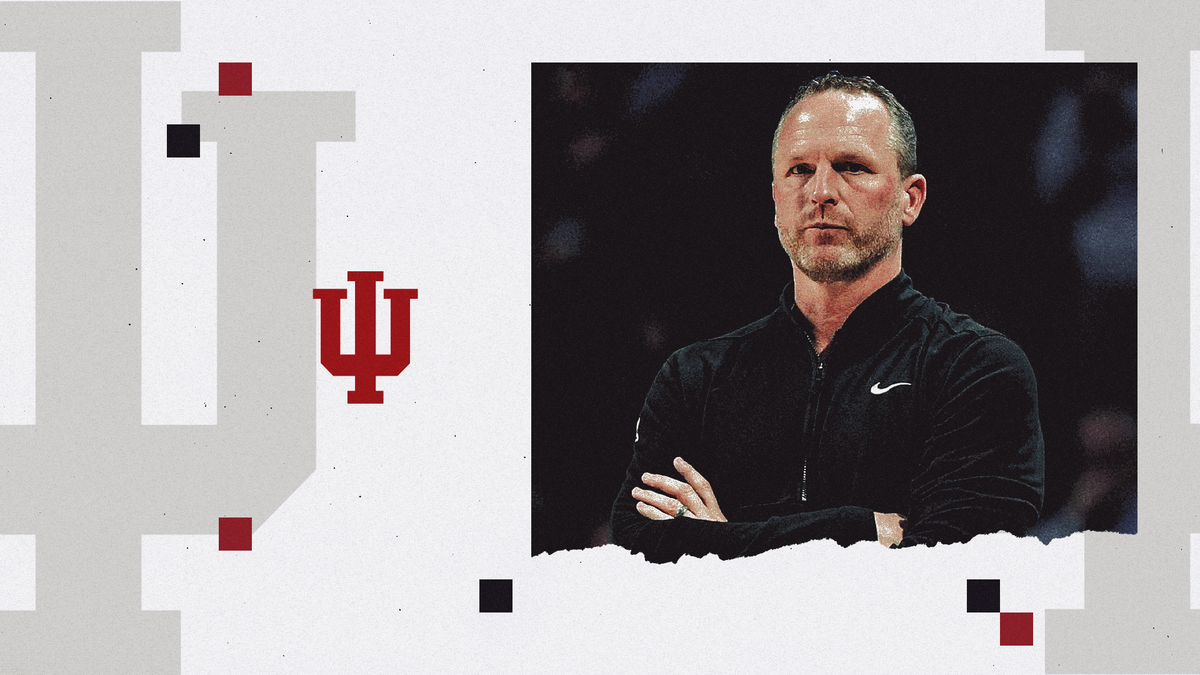
Key Returners:
Jeremy Fears Jr., Jaxon Kohler, Coen Carr, Carson Cooper
Key Newcomers:
Trey Fort, Cam Ward, Jordan Scott, Divine Ugochukwu
Key Losses:
Jace Richardson, Jaden Akins, Tre Holloman, Frankie Fidler, Szymon Zapala, Xavier Booker
Roster:

Reasons for Optimism:
As plenty of coaching legends hang it up in the new era of college basketball, Tom Izzo continues to march on as a model of consistency in East Lansing. Some worried about a dip after MSU finished outside of the KenPom top 25 three straight times from 2021-23, but a #16 finish in 2024 followed by last year’s #7 finish (and Big Ten regular season title) squashed those doubts.
The primary reason for the resurgence has been the return of a truly suffocating man-to-man defense. With multiple crucial parts of that defense back, it seems inevitable that the Spartans will be in the top 10 mix on that end once again.
It starts in the paint, where Jaxon Kohler and Carson Cooper give Izzo an active, intelligent duo who both know how to wall up at the bucket and finish possessions on the glass. Their games are not flashy, but they are extremely effective building blocks. In fact, they were particularly effective when they played together. In 198 minutes with both on the court, Michigan State racked up an absurd +27.6 Net Rating per CBB Analytics, bulldozing teams on the glass on both ends.
That dominance became even more pronounced when you added mega athlete Coen Carr alongside them. That trio logged 82 minutes together – not a huge sample, but not nothing – and posted a +28.1 Net Rating. The spacing of such a lineup seems like an obvious question mark, but MSU scored an outrageous 132.6 points per possession with that trio. Spacing doesn’t really matter when you reel in 52.1% of your misses, as that grouping did last year.
Having a wing or smallball 4 who can help protect the rim is a major benefit of Carr’s sublime hops. His block rate (4.2%) nearly matched that of Cooper and Kohler (both 4.4%), helping MSU rank 29th nationally in block rate overall. Blocks are not the be-all, end-all of defense, but that number does hint at how difficult it is to get easy buckets against the MSU interior defense.
Carr is also a tremendous cutter, making him a frequent lob target for Jeremy Fears Jr. when Carr’s man gets too focused on what’s happening elsewhere:

Back to orchestrate the offense with his elite court vision (38.9% assist rate, #8 in the country per KenPom), Fears is also a rock solid on-ball defender who can harass opposing ball-handlers up and down the court. Fears and Carr will be pivotal parts of MSU’s perimeter defense, an area that consistently holds opposing shooters below – or well below – the national average in 3P% (14 straight seasons of doing so under Izzo’s watchful eye).
Another sneaky edge on a game-to-game basis is MSU’s huge transition advantage. The Spartans push whenever they can, opportunistically hunting easy baskets before foes can get set. Per Synergy, MSU finished 19.74% of their possessions in transition, ranking 30th in the country. Unsurprisingly, Carr is especially deadly in the open floor.
At the same time, the Spartans are phenomenal at taking away the running game of their opponents, a longtime Izzo tenet. MSU surrendered a transition finish on just 11.95% of defensive possessions, ranking 329th in highest frequency allowed per Synergy. Considering how efficient open court looks are, that’s a hugely advantageous gap.
Causes for Concern:
Skeptics of Michigan State’s 2025 resurgence will point to the unlikely emergence of Jace Richardson into the Spartans’ clear offensive alpha and a one-and-done star. Without that shocking development – Richardson was ranked just 31st in the final RSCI – MSU’s offense would have been hurting for both creation and shot making.
Fears’ passing is certainly a strong place to start offensively, and Kohler can score inside some, but Carr and Cooper are both severely limited offensively. Fears will also not have the benefit of playing next to another point guard type in Tre Holloman, unless Divine Ugochukwu emerges from the pits of basketball hell that Miami (FL) dragged him into last year. He has talent and flashed some playmaking, but he was also sloppy and cannot shoot at all.
Therein lies the bigger issue: MSU might be the worst shooting power conference team in the country. Richardson was the lone excellent marksman for a team that ranked 355th nationally in percentage of points scored from beyond the arc, per KenPom. Jaden Akins and Holloman, two other competent shooters, are both gone, as well. Fears is a bricky bomber; defenses will rejoice any time he chucks one up. And Kohler, though efficient last season, is far from a volume threat.
That puts an outsized burden on Trey Fort, a gunner who will get every chance to fire away this season. He was a major weapon for Samford last year, and he showed some strong flashes at Mississippi State back in 2023-24. The Spartans also need Kur Teng to show immense development after he rode the pine last season. The former top 50ish recruit has solid pedigree and a shot maker reputation, but he does not have the luxury of being eased into a bigger role this year. That became especially true after Kaleb Glenn was lost for the season to a torn patellar tendon.
Glenn’s injury also impacts the Spartans’ overall depth, another question mark this season. MSU’s waves of bodies at every position frequently overwhelmed opponents last year, but Izzo may not have such copious lineup options this season. He is hoping redshirt freshman big man Jesse McCulloch is ready to join the rotation, though McCulloch also dealt with a stress fracture in his foot during pivotal offseason developmental time.
Minutes are definitely available for freshmen wing/forwards Cam Ward and Jordan Scott. To my eye, Scott appears more imminently capable thanks to his shooting potential and length. But Ward’s ball skills at his size are also intriguing, and he is even longer than Scott. Whether Izzo trusts either rookie immediately, though, remains to be seen, especially since both need to add strength.
Bottom Line:
Michigan State looks like a fairly predictable kind of team. The Spartans will be tough as nails defensively and rule the paint and the boards with an iron fist thanks to Kohler, Cooper and Carr. However, they will likely lack the offensive burst and upside to repeat last year’s high-end success. If the defense remains among the elite, then MSU can crack the top 20 nationally, but the shooting, creation, and depth limitations could relegate them more towards the 25-35 range.
The real downside is if no one on the bench is truly ready for Big Ten minutes. Without any depth, MSU’s high-effort rebounding and defensive scheme could experience some cracks, sinking the Spartans towards the NCAA Tournament bubble.


